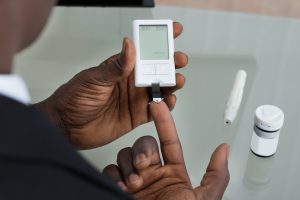
Among one of the most serious complications of a medical supply shortage is shortage of insulin for insulin dependent diabetics. The threat is getting very real, given current events.
- October 2021 Michigan pharmacy runs out of insulin
- As recent as December 2021 Arkansas pharmacies saw a shortage of insulin.
- And more recently, March 2022 Severe shortage of insulin in war torn Ukraine
- Also, March 2022 Novo Nordisk supply shortage reported
The media has been very quiet about medical supply chains. Given the instability of the entire world, sanctions, ports closed, Chinas largest city in lockdown, the time to prepare is YESTERDAY. The next best time is NOW.
- Only three companies—Novo Nordisk, Sanofi, and Eli Lilly—provide insulin to the United States market.
- The American Diabetes Association (ADA) estimated that more than 30 million Americans, or more than 9 percent of the population live with diabetes
According to the ADA:” What is insulin dependent diabetes?
Diabetes is a problem with your body that causes blood sugar (also called blood glucose) levels to rise higher than normal. This is also called hyperglycemia.
When you eat, your body breaks food down into sugar and sends it into the blood. Insulin then helps move the sugar from the blood into your cells. When sugar enters your cells, it is either used as fuel for energy right away or stored for later use. In a person with diabetes, there is a problem with insulin. But, not everyone with diabetes has the same problem.
In type 1 diabetes, your immune system mistakenly treats the beta cells in your pancreas that make insulin as foreign invaders and destroys them. This can happen over a few weeks, months, or years.
When enough beta cells are gone, your pancreas stops making insulin or makes so little insulin that you need to take insulin to live. Type 1 diabetes develops most often in young people but can also appear in adults.”
Covid infection will lead to supply strain due to increase in insulin dependent diabetes diagnosis
SARS-CoV-2 INFECTION LEADING TO TYPE 1 DIABETES
According to the NIH SARS-CoV-2 site titled “The diabetes virus” SARS-CoV-2 can interact with several proteins on the surface of cells in the body, allowing the virus to gain access to the cell. But those proteins are present in different levels for different cells. Researchers discovered that beta cells — the cells that make insulin in the pancreas — have a higher level of one of those proteins, neuropilin, than other pancreatic cells. In one study, researchers examined lab-grown beta cells infected with COVID-19 and found that they made less insulin when infected with the virus. Some of the cells died outright.
In the other study, researchers found that infection effectively reprogrammed some of those lab-grown cells. Instead of producing insulin, which breaks down blood sugar, they started producing glucagon, which increases blood sugar.

The following isn’t medical advice, consult your healthcare provider for your medical needs
What to do if you are unable to get insulin

- Consider adding clove extract: Clove extract has been shown to stimulate beta cells in pancreas to produce insulin in addition to lowering blood sugar in non-insulin dependent diabetics
- Stock up on extra insulin. Ask your care provider for extra vials due to the supply chain shortage. If they won’t accommodate your request, find one that will. Do this today if you haven’t already.
- Rotate your insulin, using oldest unexpired insulin first
- If electricity is out, you will need to find a way to keep your insulin cool. An ice chest with ice for short term storage is an option. A better option is a cooler you can plug into your car or home such as this one: K-Box Electric Cooler and Warmer for Car and Home – 34 Quart (32 Liter) – Dual 110V AC House and 12V DC Vehicle Plugs
- Make sure you have plenty of supplies- lancets, syringes etc, Buy extra of everything and then some
- Follow a strict diet. Don’t deviate. Keep carbs to a minimum
- Be sure to have electrolyte solution or powder available in case of high blood sugar readings. Electrolytes are lost during these episodes. Keep hydrated!
- Keep stress level at a minimum, pray, meditate, read, do art, garden. Stress raises cortisol levels, which in turn raise blood sugar levels
- If there is truly no insulin you may want to consider rationing your doses. Your ideal blood sugar reading may be higher than ideal by doing this. The danger of this is ketoacidosis. (see below for signs and symptoms of ketoacidosis) This will be a judgement call on your part
- Have extra supplies- lancets, testing strips, syringes,
- Make sure you have enough batteries for your glucometer
- Have a backup glucometer along with supplies in case of malfunction
- Let everyone in your group know you are insulin dependent and educate all members on what normal glucose ranges are for you, signs, and symptoms of high and low blood sugar and what to do if your blood sugars are too high (or too low)
- Instruct all able-bodied members on use of your glucometer
Diabetic Ketoacidosis, a real threat during an insulin shortage
Diabetic ketoacidosis (DKA) is life-threatening—learn the warning signs to be prepared for any situation.
DKA is no joke, it’s a serious condition that can lead to diabetic coma or even death. DKA is caused by an overload of ketones present in your blood.
When your cells don’t get the glucose they need for energy, your body begins to burn fat for energy, which produces ketones. Ketones are chemicals that the body creates when it breaks down fat to use for energy. The body does this when it doesn’t have enough insulin to use glucose, the body’s normal source of energy. When ketones build up in the blood, they make it more acidic. They are a warning sign that your diabetes is out of control or that you are getting sick.
DKA usually develops slowly. But when vomiting occurs, this life-threatening condition can develop in a few hours. Early symptoms include the following:
- Thirst or a very dry mouth
- Frequent urination
- High blood glucose (blood sugar) levels
- High levels of ketones in the urine
Then, other symptoms appear:
- Constantly feeling tired
- Dry or flushed skin
- Nausea, vomiting, or abdominal pain. Vomiting can be caused by many illnesses, not just ketoacidosis. If vomiting continues for more than two hours, contact your health care provider.
- Difficulty breathing
- Fruity odor on breath
- A hard time paying attention, or confusion
Warning! DKA is dangerous and serious. If you have any of the above symptoms, contact your health care provider IMMEDIATELY, or go to the nearest emergency room of your local hospital.
(Just as life threatening but less common if lack of insulin)
If blood sugar levels become too low, signs and symptoms can include:
- An irregular or fast heartbeat
- Fatigue
- Pale skin
- Shakiness
- Anxiety
- Sweating
- Hunger
- Irritability
- Tingling or numbness of the lips, tongue or cheek
As hypoglycemia worsens, signs and symptoms can include:
- Confusion, abnormal behavior or both, such as the inability to complete routine tasks
- Visual disturbances, such as blurred vision
- Seizures
- Loss of consciousness
When to see a doctor
Seek a doctor’s help immediately if:
- You have what might be hypoglycemia symptoms and you don’t have diabetes
- You have diabetes and hypoglycemia isn’t responding to treatment, such as drinking juice or regular soft drinks, eating candy, or taking glucose tablets
Seek emergency help for someone with diabetes or a history of hypoglycemia who has symptoms of severe hypoglycemia or loses consciousness.
